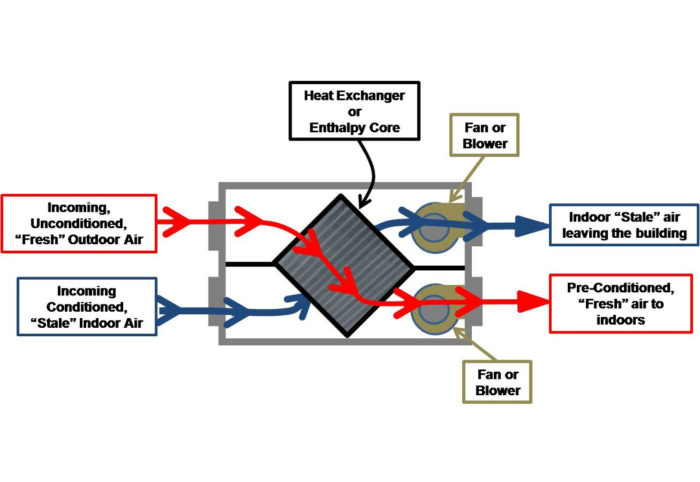Exactly How Heat Recovery Ventilation Enhances Indoor Air High Quality and Reduces Power Costs
Heat Recovery Ventilation (HRV) systems play a necessary role in boosting indoor air top quality while concurrently decreasing energy expenditures. By effectively trading stale interior air with fresh outdoor air, HRVs aid maintain perfect moisture and minimize pollutants. Furthermore, their ability to recoup heat from outward bound air minimizes the stress on home heating and cooling systems. As power prices remain to climb, understanding the full possibility of HRV systems ends up being increasingly essential for home owners and companies alike.
Recognizing Heat Recovery Ventilation Equipments

Heat recovery ventilation (HRV) systems play a vital duty in improving indoor air high quality, especially in modern-day, energy-efficient structures. These systems are designed to transfer warm from the outbound stagnant air to the inbound fresh air, thus minimizing energy loss while maintaining optimal temperature level degrees inside. HRVs include a heat exchanger, followers, and ductwork, helping with the continual circulation of air. By getting rid of interior contaminants and presenting fresh air, HRVs aid to balance moisture degrees, prevent mold and mildew development, and reduce allergens. The efficiency of HRV systems hinges on their ability to recover up to 80% of the heat from the worn down air, advertising power preservation while making sure a healthy and balanced indoor environment. Their assimilation is essential in attaining lasting living methods.
The Value of Indoor Air Top Quality
Indoor air quality (IAQ) is a critical variable affecting the health and wellness and well-being of owners in any kind of environment. Poor IAQ can lead to numerous health and wellness concerns, consisting of respiratory system problems, allergies, and exhaustion. Additionally, it can intensify status quo such as asthma. Elements adding to reduced IAQ include pollutants from indoor resources like cleaning representatives, mold and mildew, and insufficient air flow. Subsequently, preserving great IAQ is crucial for promoting a secure and comfy living or functioning room. Efficient strategies to enhance IAQ entail routine tracking of air top quality, appropriate air flow systems, and decreasing the usage of damaging materials inside your home. By prioritizing IAQ, people can guarantee a healthier setting that fosters performance and overall high quality of life.
Energy Effectiveness Perks of HRV Equipments
Many house owners and structure managers are increasingly acknowledging the energy effectiveness advantages of warm recuperation air flow (HRV) systems. By moving warmth from worn down interior air to inbound fresh air, HRV systems considerably reduce the power needed for cooling and heating. This procedure minimizes dependence on traditional HVAC systems, resulting in lower power costs. Additionally, HRVs assist preserve a balanced interior environment, protecting against too much home heating or cooling down needs. The capability to recover up to 90% of the heat from outgoing air additionally sustains sustainability initiatives by minimizing general energy consumption. HRV systems contribute not just to cost savings however also to a decreased carbon footprint, lining up with the expanding emphasis on energy-efficient structure techniques.
Installment and Upkeep Considerations
The reliable execution of heat recovery air flow (HRV) systems calls for mindful factor to consider of installation and maintenance factors to ensure peak performance. Correct positioning of the HRV system is important, as it ought to be installed in a location that makes best use of air movement while decreasing sound interruption. In addition, ductwork needs to be appropriately sized and protected to avoid power loss. Regular upkeep, including filter substitute and system cleansing, is important to protect optimal functionality and interior air top quality. Owners must establish a normal upkeep routine to identify and resolve prospective issues prior to they rise. Partnership with experienced professionals during both installation and maintenance stages can improve the longevity and performance of HRV systems, ultimately bring about much better indoor settings and decreased power costs.
Real-World Applications and Success Stories
Exploring real-world applications of heat recuperation ventilation (HRV) systems discloses their substantial influence on interior air top quality and energy effectiveness across different settings. In household structures, property owners have actually reported better air high quality, causing less allergic reactions and respiratory system issues. Schools applying HRV systems have actually kept in mind boosted pupil concentration and lowered absence as a result of much better air flow. Commercial buildings, such as offices and retail rooms, have experienced lower power costs and increased employee efficiency. A company workplace in a temperate climate achieved a 30% decrease in power bills after mounting an HRV system. click for source These success tales demonstrate that HRV innovation not only contributes to much healthier environments however also gives substantial monetary advantages, making it an important investment for various markets.
Often Asked Concerns
Can HRV Systems Reduce Allergens in Indoor Air?
The efficiency of HRV systems in reducing indoor irritants mainly hinges on their ability to filter and exchange air. HRV Heat Recovery Ventilation. By continually changing stagnant air, these systems can greatly lower Check Out Your URL allergen degrees throughout indoor atmospheres

How Does Moisture Affect HRV System Efficiency?
Moisture considerably influences HRV system efficiency; high degrees can result in condensation, decreasing efficiency, while reduced humidity might enhance air exchange. Balancing moisture is vital for optimal operation and keeping interior air high quality.
Are HRV Systems Noisy During Procedure?
HRV systems can generate varying sound degrees throughout procedure, depending upon their layout and setup. Some systems run silently, while others might generate noticeable noise, specifically at greater airflow setups or when inadequately preserved.
What Is the Ordinary Life Expectancy of an HRV System?

Can HRV Solutions Be Used in All Environments?
HRV systems can be made use of in various climates, but their effectiveness might differ - HRV Heat Recovery Ventilation. In extreme temperatures, changes or extra systems might moved here be required to ensure excellent performance and convenience while keeping interior air top quality